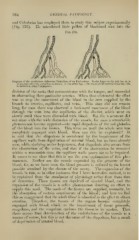Page 674 - My FlipBook
P. 674
684 GENERAL PATHOLOGY.
and Cohnheim has employed them to study this subject experimentally
(Fig. 376). He introduced little pellets of blackened wax into the
Diagram of the conditions following Embolism of an End-artery. In the figure to the left the state
oC antt'uiia altei the eiiiboliMii is shown ; in the other tigiire the regurgitant current from the vein
is indicated (after Cohnheim).
division of the aorta that communicates with the tongue, and succeeded
in obstructing these particular arteries. When thus obstructed the effect
was to stop the luovement of the blood in the area supplied by the
branch in arteries, capillaries, and veins. This state did not remain
long, for soon there was observed a backward movement of the blood
through the vein into the capillaries of the district, which went on
slowly until these were distended with blood. But the movement did
not cease with the wide distension of the vessels, for soon a remarkable
phenomenon became apparent—the rapid diapedesis of the red globules
of the blood into the ti.ssues. This went on until the whole area was
completely engorged with blood. How can this be explained? It
is said that the diapedesis is occasioned by the impairment of the
capillary walls from deprivation of arterial blood, but we have already
seen, while studying active hypersemia, that diapedesis also occurs from
the ob.struction of the veins, and that if the obstruction be removed
within a reasonable time, the capillary walls prove not to be impaired.
It seems to me clear that this is not the true explanation of this phe-
nomenon. Neither are the vessels expanded by the pressure of the
blood, for, as we have seen, the blood-pressure is reduced to the lowest
possible standard by the clo.-^ure of the artery. The expansion of the
vessels in this, as in other instances that I have heretofore noticed, is to
be explained from the standpoint of physiology rather than from that
of dynamics. These tissues are deprived of aerated blood, and the
expansion of the vessels is a reflex phenomenon denoting an effort to
supply this need. The needs of the tissues are supplied, normally, by
the absorption of certain constituents of the blood ; and here we find
this so exaggeratc
engorged with blood, which,' as the impairment of tissue proceeds,
coagulates, and the coagulum encloses the tissue in its meshes. That
there occurs final deterioration of the endothelium of the vessels is a
matter of course, but this is not the cause of the diapedesis, but a result
of deprivation of aerated blood.


